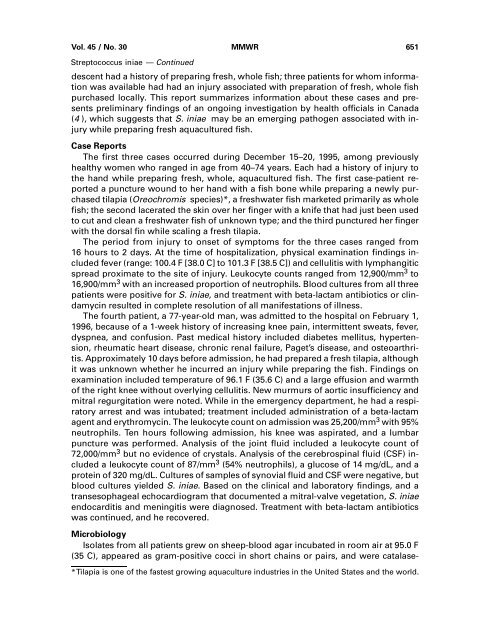Fatalities Associated with Ingestion of Diethylene Glycol ...
Fatalities Associated with Ingestion of Diethylene Glycol ...
Fatalities Associated with Ingestion of Diethylene Glycol ...
Create successful ePaper yourself
Turn your PDF publications into a flip-book with our unique Google optimized e-Paper software.
Vol. 45 / No. 30 MMWR 651<br />
Streptococcus iniae — Continued<br />
descent had a history <strong>of</strong> preparing fresh, whole fish; three patients for whom information<br />
was available had had an injury associated <strong>with</strong> preparation <strong>of</strong> fresh, whole fish<br />
purchased locally. This report summarizes information about these cases and presents<br />
preliminary findings <strong>of</strong> an ongoing investigation by health <strong>of</strong>ficials in Canada<br />
(4 ), which suggests that S. iniae may be an emerging pathogen associated <strong>with</strong> injury<br />
while preparing fresh aquacultured fish.<br />
Case Reports<br />
The first three cases occurred during December 15–20, 1995, among previously<br />
healthy women who ranged in age from 40–74 years. Each had a history <strong>of</strong> injury to<br />
the hand while preparing fresh, whole, aquacultured fish. The first case-patient reported<br />
a puncture wound to her hand <strong>with</strong> a fish bone while preparing a newly purchased<br />
tilapia (Oreochromis species)*, a freshwater fish marketed primarily as whole<br />
fish; the second lacerated the skin over her finger <strong>with</strong> a knife that had just been used<br />
to cut and clean a freshwater fish <strong>of</strong> unknown type; and the third punctured her finger<br />
<strong>with</strong> the dorsal fin while scaling a fresh tilapia.<br />
The period from injury to onset <strong>of</strong> symptoms for the three cases ranged from<br />
16 hours to 2 days. At the time <strong>of</strong> hospitalization, physical examination findings included<br />
fever (range: 100.4 F [38.0 C] to 101.3 F [38.5 C]) and cellulitis <strong>with</strong> lymphangitic<br />
spread proximate to the site <strong>of</strong> injury. Leukocyte counts ranged from 12,900/mm 3 to<br />
16,900/mm 3 <strong>with</strong> an increased proportion <strong>of</strong> neutrophils. Blood cultures from all three<br />
patients were positive for S. iniae, and treatment <strong>with</strong> beta-lactam antibiotics or clindamycin<br />
resulted in complete resolution <strong>of</strong> all manifestations <strong>of</strong> illness.<br />
The fourth patient, a 77-year-old man, was admitted to the hospital on February 1,<br />
1996, because <strong>of</strong> a 1-week history <strong>of</strong> increasing knee pain, intermittent sweats, fever,<br />
dyspnea, and confusion. Past medical history included diabetes mellitus, hypertension,<br />
rheumatic heart disease, chronic renal failure, Paget’s disease, and osteoarthritis.<br />
Approximately 10 days before admission, he had prepared a fresh tilapia, although<br />
it was unknown whether he incurred an injury while preparing the fish. Findings on<br />
examination included temperature <strong>of</strong> 96.1 F (35.6 C) and a large effusion and warmth<br />
<strong>of</strong> the right knee <strong>with</strong>out overlying cellulitis. New murmurs <strong>of</strong> aortic insufficiency and<br />
mitral regurgitation were noted. While in the emergency department, he had a respiratory<br />
arrest and was intubated; treatment included administration <strong>of</strong> a beta-lactam<br />
agent and erythromycin. The leukocyte count on admission was 25,200/mm 3 <strong>with</strong> 95%<br />
neutrophils. Ten hours following admission, his knee was aspirated, and a lumbar<br />
puncture was performed. Analysis <strong>of</strong> the joint fluid included a leukocyte count <strong>of</strong><br />
72,000/mm 3 but no evidence <strong>of</strong> crystals. Analysis <strong>of</strong> the cerebrospinal fluid (CSF) included<br />
a leukocyte count <strong>of</strong> 87/mm 3 (54% neutrophils), a glucose <strong>of</strong> 14 mg/dL, and a<br />
protein <strong>of</strong> 320 mg/dL. Cultures <strong>of</strong> samples <strong>of</strong> synovial fluid and CSF were negative, but<br />
blood cultures yielded S. iniae. Based on the clinical and laboratory findings, and a<br />
transesophageal echocardiogram that documented a mitral-valve vegetation, S. iniae<br />
endocarditis and meningitis were diagnosed. Treatment <strong>with</strong> beta-lactam antibiotics<br />
was continued, and he recovered.<br />
Microbiology<br />
Isolates from all patients grew on sheep-blood agar incubated in room air at 95.0 F<br />
(35 C), appeared as gram-positive cocci in short chains or pairs, and were catalase-<br />
*Tilapia is one <strong>of</strong> the fastest growing aquaculture industries in the United States and the world.
















